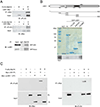LSD1 Interacts with Zfp516 to Promote UCP1 Transcription and Brown Fat Program
- PMID: 27264172
- PMCID: PMC4916264
- DOI: 10.1016/j.celrep.2016.05.019
LSD1 Interacts with Zfp516 to Promote UCP1 Transcription and Brown Fat Program
Abstract
Zfp516, a brown fat (BAT)-enriched and cold-inducible transcription factor, promotes transcription of UCP1 and other BAT-enriched genes for non-shivering thermogenesis. Here, we identify lysine-specific demethylase 1 (LSD1) as a direct binding partner of Zfp516. We show that, through interaction with Zfp516, LSD1 is recruited to UCP1 and other BAT-enriched genes, such as PGC1α, to function as a coactivator by demethylating H3K9. We also show that LSD1 is induced during brown adipogenesis and that LSD1 and its demethylase activity is required for the BAT program. Furthermore, we show that LSD1 ablation in mice using Myf5-Cre alters embryonic BAT development. Moreover, BAT-specific deletion of LSD1 via the use of UCP1-Cre impairs the BAT program and BAT development, making BAT resemble WAT, reducing thermogenic activity and promoting obesity. Finally, we demonstrate an in vivo requirement of the Zfp516-LSD1 interaction for LSD1 function in BAT gene activation.
Copyright © 2016 The Authors. Published by Elsevier Inc. All rights reserved.
Figures






References
-
- Bartelt A, Bruns OT, Reimer R, Hohenberg H, Ittrich H, Peldschus K, Kaul MG, Tromsdorf UI, Weller H, Waurisch C, et al. Brown adipose tissue activity controls triglyceride clearance. Nature medicine. 2011;17:200–205. - PubMed
-
- Choi J, Jang H, Kim H, Kim ST, Cho EJ, Youn HD. Histone demethylase LSD1 is required to induce skeletal muscle differentiation by regulating myogenic factors. Biochemical and biophysical research communications. 2010;401:327–332. - PubMed
-
- Collins S, Yehuda-Shnaidman E, Wang H. Positive and negative control of Ucp1 gene transcription and the role of beta-adrenergic signaling networks. International journal of obesity (2005) 2010;34(Suppl 1):S28–S33. - PubMed
MeSH terms
Substances
Grants and funding
LinkOut - more resources
Full Text Sources
Other Literature Sources
Molecular Biology Databases

